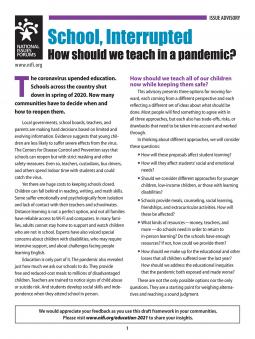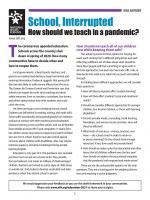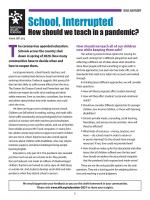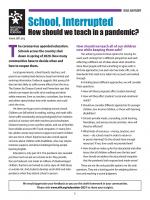How should we teach in a pandemic?
Scroll down for the School, Interrupted issue advisory and other related materials.
Need help with your order? Contact customer service.
The coronavirus upended education. Schools across the country shut down in spring of 2020. Now many communities have to decide when and how to reopen them.
Local governments, school boards, teachers, and parents are making hard decisions based on limited and evolving information. Evidence suggests that young children are less likely to suffer severe effects from the virus. The Centers for Disease Control and Prevention says that schools can reopen but with strict masking and other safety measures. Even so, teachers, custodians, bus drivers, and others spend indoor time with students and could catch the virus.
Yet there are huge costs to keeping schools closed. Children can fall behind in reading, writing, and math skills. Some suffer emotionally and psychologically from isolation and lack of contact with their teachers and schoolmates. Distance learning is not a perfect option, and not all families have reliable access to Wi-Fi and computers. In many families, adults cannot stay home to support and watch children who are not in school. Experts have also voiced special concerns about children with disabilities, who may require intensive support, and about challenges facing people learning English.
Education is only part of it. The pandemic also revealed just how much we ask our schools to do. They provide free and reduced-cost meals to millions of disadvantaged children. Teachers are trained to notice signs of child abuse or suicide risk. And students develop social skills and independence when they attend school in person.
How should we teach all of our children now while keeping them safe?
This advisory presents three options for moving forward, each coming from a different perspective and each reflecting a different set of ideas about what should be done. Most people will find something to agree with in all three approaches, but each also has trade-offs, risks, or drawbacks that need to be taken into account and worked through.
In thinking about different approaches, we will consider these questions:
- How will these proposals affect student learning?
- How will they affect students’ social and emotional needs?
- Should we consider different approaches for younger children, low-income children, or those with learning disabilities?
- Schools provide meals, counseling, social learning, friendships, and extracurricular activities. How will these be affected?
- What kinds of resources—money, teachers, and more —do schools need in order to return to in-person learning? Do the schools have enough resources? If not, how could we provide them?
- How should we make up for the educational and other losses that all children suffered over the last year? How should we address the educational inequities that the pandemic both exposed and made worse?
These are not the only possible options nor the only questions. They are a starting point for weighing alternatives and reaching a sound judgment.




